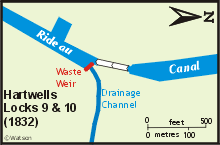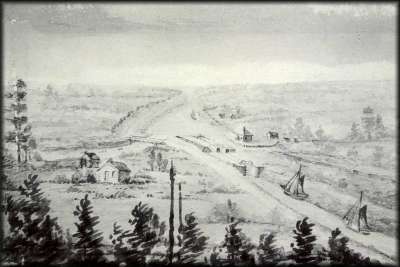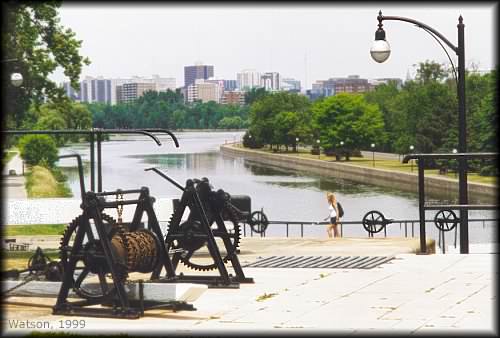Hartwells - Locks 9 and 10
| location map | lockstation information |
The Setting
The position that was chosen for Hartwells was a few hundred yards (metres) south of Dow’s Great Swamp, where the ground started to rise up towards Hogs Back. Prior to the canal there was no water course in this area.
The Plan
Originally, no locks were to be constructed here. A canal cut was supposed to extend from the top of the Ottawa Locks all the way to Hogs Back, where three locks were planned. However, on closer surveying, Colonel By realized that by placing two of his three Hogs Back Locks here at Hartwells, he could save a great deal of excavation.
There were no natural features here, these locks were to be placed in the middle of a man made canal cut. There was some natural drainage to the southeast, towards the Rideau River. It was planned to build two locks and a waste weir to channel away excess water.
Building of the Locks
The original contractor was to be Walter Fenlon, but after he quit in 1828 the contract was awarded to the partnership of John Redpath and Thomas McKay, with McKay as the on-site contractor. The two locks, each with a lift of 11 feet (3.4 m), were excavated in unstable clay filled with boulders. It's to be noted that no bedrock was ever found between Hogs Back and the Beaver Meadow near the top of the Ottawa Locks, even though excavations at times exceeded 30 feet (9.1 m).
 Due to the nature of the ground, inverted masonry arches were used to support the floor of the lock. As was the case at many Rideau locks, grout was used to seal the lock wall and basin, and in particular, the area of the inverted arches. The idea was to make a solid mass of masonry. "Pressure" grouting was achieved by boring holes in the works at regular intervals. A tube was stuck in the hole and sealed with clay. The tube would extend to the top of the lock, usually 12 to 15 feet (3.7 - 4.6 m), the higher, the better. A funnel was attached to the top of the tube and hydraulic cement poured in. Due to the nature of the ground, inverted masonry arches were used to support the floor of the lock. As was the case at many Rideau locks, grout was used to seal the lock wall and basin, and in particular, the area of the inverted arches. The idea was to make a solid mass of masonry. "Pressure" grouting was achieved by boring holes in the works at regular intervals. A tube was stuck in the hole and sealed with clay. The tube would extend to the top of the lock, usually 12 to 15 feet (3.7 - 4.6 m), the higher, the better. A funnel was attached to the top of the tube and hydraulic cement poured in.
On the east side of the canal, just above the lock, a masonry waste weir was built to carry excess water over to the Rideau River.
 |
Hartwell's Locks, ca.1845
John Burrows, watercolour over pencil, Archives of Ontario
In this view of Hartwells Locks, the masonry weir can be seen carrying off water to the left of the locks. On the right is the defensible lockmaster’s house, built in the early 1840s. |
Through the Years
A defensible lockmaster's house was built sometime prior to 1845. In its original state, it was a small, one storey, square stone structure. These were not ideal living quarters, especially as the years went by and the building deteriorated. As Superintendent Phillips (superintendent from 1894 to 1934) was quoted as saying, "These cottages are all of the same pattern, being square stone structures of one story only, and although everything has been done to keep them dry that can be suggested, yet they appear to be still damp and unhealthy; and repairs to them only seem to be a waste of money, as they are over 70 years old." In 1901, a second storey was added to the building and the interior walls altered to make the building more liveable. The clapboard that now covers the original stone of the structure was likely added at that time.
The locks themselves held up well, although much of the stonework had to be replaced due to the ravages of water and ice over the years. In the 1920s, the stone facing of the upper lock was replaced with concrete blocks. The canal cuts above and below the locks were lined with rock, and later, concrete walls were built to prevent erosion from the wash of passing vessels. The waste weir was eventually removed and replaced with an underground culvert. The area over which the waste water used to be discharged is now occupied by Carleton University.
 |
Hartwells Locks
photo by: Ken Watson, 1999
The City of Ottawa looms in the background, a contrast to the 19th century crabs that still operate the locks to this day. The canal in this area is characterized by manicured banks, large shade trees, and paved bicycle paths. |
The Lockmasters to 2000
The first lockmaster at Hartwells was probably William Clyma, a corporal in the 15th Company of Royal Sappers and Miners, who was proposed by By in 1831. At some point, perhaps quite early on, he was replaced by Henry Bullen, who took ill in September 1847 and was replaced by James Pilson. Pilson retired on February 4, 1868 and was replaced by his son Henry Pilson who was retired in May 1898 on the grounds of ill health. He was followed by Thomas Foran of Billings Bridge who retired in November 1911 and was succeeded by Robert Slack of Merivale who was lockmaster until some time after 1934/35. He was followed by Allan C. Moses from 1935 to 1946; A. Dale from 1947 to 1948; unknown (most likely Allan C. Moses who retired here in 1953) from 1949 to 1953; R.G. Dale from 1954 to 1960; R.J. Barrett from 1961 to 1969; Danny Danielson from 1969 to 1974; unknown in 1975; Andy St. Amour (may have been acting lockmaster) from 1976 to 1977; Walter Bown in 1977 (combined with Hogs Back); Marcel Belanger from 1978 to 1979 (and possibly in the 1980s); unknown from 1980 to 1984; Louise Hamelin acting in 1985; unknown from 1986 to 1988; Jim Gibbs in 1989; Cedric Beaudry acting in 1990; unknown in 1991; John Young in 1992; unknown from 1993 to 1997 and John Cooke from 1997 to 1999.
|